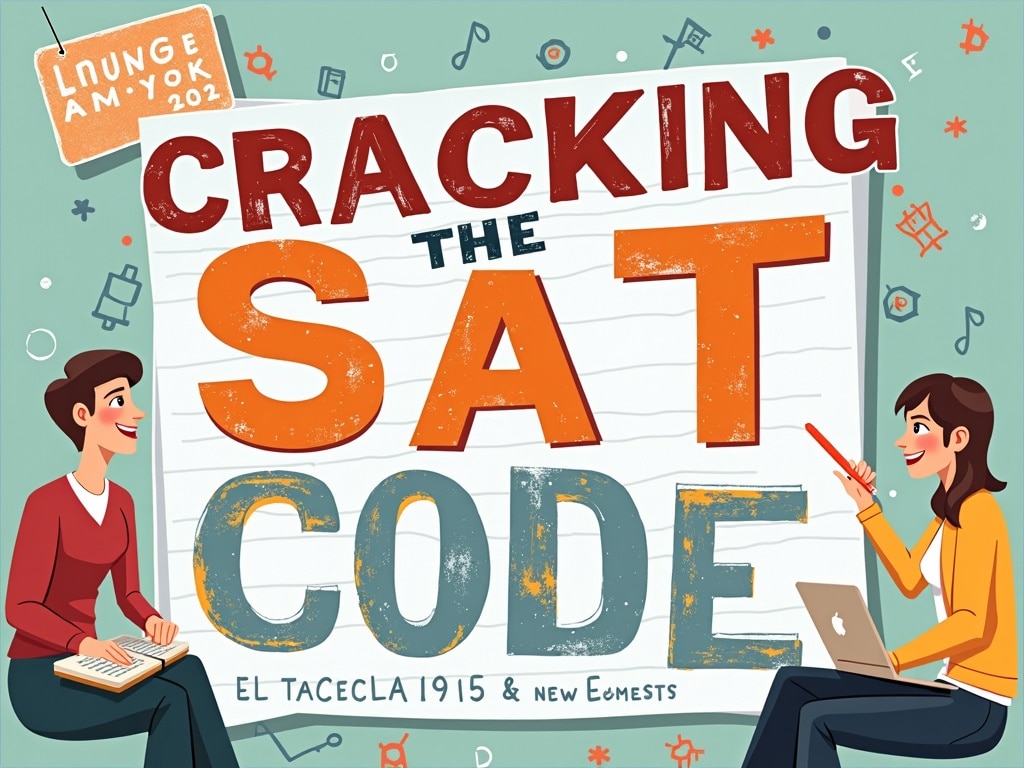Cracking the SAT Code: Exclusive Insider Tips and Recommended Prep Courses
The SAT. Just the acronym itself can send shivers down the spines of high school students everywhere. It’s the gatekeeper, the hurdle, the standardized test that looms large on the path to college acceptance. But what if we told you that the SAT isn’t an insurmountable monster? What if, with the right strategy and preparation, you could not only conquer the SAT but actually thrive? This comprehensive guide will unlock the secrets to SAT success, providing insider tips, expert advice, and a curated list of recommended SAT prep courses to help you achieve your target score.
Why the SAT Matters: Your Ticket to College
So, what exactly is the SAT, and why does it hold so much weight in the college admissions process? The SAT, or Scholastic Assessment Test, is a standardized test designed to assess a student’s readiness for college. Colleges use SAT scores as one factor—among grades, essays, extracurricular activities, and recommendations—to evaluate applicants. It provides a common yardstick, allowing admissions officers to compare students from different high schools and backgrounds.
- Standardized Comparison: Levels the playing field for students from diverse academic environments.
- Predictive Validity: Studies suggest a correlation between SAT scores and college GPA.
- Scholarship Opportunities: High SAT scores can unlock access to merit-based scholarships and financial aid.
- Demonstrated Skills: Showcases critical thinking, problem-solving, and reading comprehension abilities.
While some colleges are test-optional, many still consider SAT scores as a valuable component of your application. Excelling on the SAT can significantly increase your chances of acceptance into your dream school and open doors to financial assistance.
Decoding the SAT: Structure, Timing, and Question Types
To conquer the SAT, you must first understand its anatomy. The current SAT consists of two main sections:
- Math: Assesses your mathematical reasoning skills, covering algebra, problem-solving and data analysis, and geometry and trigonometry.
- Reading and Writing: Evaluates your reading comprehension, analysis, and writing and language skills.
Here’s a breakdown of the sections and timing:
- Reading: 52 questions, 65 minutes
- Writing and Language: 44 questions, 35 minutes
- Math (No Calculator): 20 questions, 25 minutes
- Math (Calculator): 38 questions, 55 minutes
- Optional Essay: Not part of the standard SAT score, but some colleges may require or recommend it.
Understanding the structure and timing is essential for pacing yourself effectively during the exam. Familiarize yourself with the different question types within each section, such as multiple-choice questions, grid-in questions in math, and passage-based questions in reading and writing.
The Power of Personalized SAT Prep
One-size-fits-all approaches rarely work in SAT prep. The most effective strategy is personalized preparation tailored to your specific strengths and weaknesses. Start with a diagnostic test to identify your baseline score and pinpoint areas that require the most attention. This will allow you to create a targeted study plan and maximize your study time.
Personalized SAT prep might include:
- Targeted practice: Focusing on question types and content areas where you struggle.
- Individualized feedback: Receiving personalized feedback on your practice tests and essays.
- Adaptive learning: Using technology to adjust the difficulty level of practice questions based on your performance.
- One-on-one tutoring: Working with a tutor to address your specific needs and learning style.
Deep Dive: Essential Concepts for SAT Math
The SAT Math section covers a range of mathematical concepts, including:
- Algebra: Linear equations, systems of equations, inequalities, functions, and polynomials.
- Problem-Solving and Data Analysis: Ratios, proportions, percentages, statistics, and interpreting data.
- Geometry and Trigonometry: Angles, triangles, circles, and trigonometric functions.
Mastering these core concepts is crucial for success on the SAT Math section. Focus on understanding the underlying principles and practicing applying them to various types of problems.
Decoding the Language: Mastering SAT Reading and Writing
The SAT Reading and Writing section assesses your ability to comprehend and analyze written passages and to identify and correct errors in grammar and usage. Key concepts include:
- Reading Comprehension: Understanding the main idea, supporting details, and purpose of a passage.
- Evidence-Based Reading: Identifying evidence in the passage that supports your answers.
- Grammar and Usage: Subject-verb agreement, pronoun agreement, comma usage, and other grammatical rules.
- Rhetorical Skills: Understanding how authors use language to persuade, inform, and entertain.
Improving your reading comprehension and grammar skills is essential for scoring well on this section. Practice reading a variety of texts and focusing on identifying the author’s main points and purpose.
Dominate the Test: Proven Strategies for Each SAT Section
Beyond knowing the content, strategic test-taking is essential. Here are some proven strategies for each section:
- Math:
- Plug in numbers: When a problem involves variables, try plugging in numbers to simplify the problem.
- Eliminate answer choices: Eliminate obviously wrong answer choices to increase your odds of guessing correctly.
- Use your calculator wisely: Use your calculator to perform calculations quickly and accurately.
- Reading:
- Read the questions first: Read the questions before reading the passage to focus your reading.
- Underline key information: Underline key information in the passage as you read.
- Use process of elimination: Eliminate answer choices that are not supported by the passage.
- Writing:
- Read the entire sentence: Read the entire sentence before answering the question.
- Look for errors in grammar and usage: Pay attention to subject-verb agreement, pronoun agreement, and comma usage.
- Choose the clearest and most concise answer: Choose the answer that is the most clear and concise.
Practice Makes Perfect: Mastering the SAT with Practice Tests
Taking practice tests is the most effective way to improve your SAT score. Practice tests allow you to familiarize yourself with the test format, timing, and question types. They also help you identify your strengths and weaknesses.
When taking practice tests, be sure to:
- Simulate test conditions: Take the test in a quiet environment and time yourself according to the official SAT timing.
- Review your answers: Review your answers carefully and identify the reasons why you got questions wrong.
- Track your progress: Track your scores on each practice test to monitor your progress.
Conquer Your Weaknesses: A Personalized Study Plan
Once you’ve identified your weaknesses, create a personalized study plan to address them. Your study plan should include:
- Specific goals: Set specific goals for each section of the SAT.
- A detailed schedule: Create a detailed schedule that outlines what you will study each day.
- Practice materials: Gather practice materials, such as practice tests, workbooks, and online resources.
- Regular review: Regularly review the concepts you’ve learned.
SAT Prep Courses vs. Self-Study: Which Path is Right for You?
Choosing between an SAT prep course and self-study depends on your learning style, budget, and level of motivation. SAT prep courses offer structured learning, expert instruction, and personalized feedback. Self-study allows you to learn at your own pace and focus on your specific needs.
Consider a prep course if:
- You prefer structured learning.
- You need expert guidance.
- You benefit from personalized feedback.
Consider self-study if:
- You are self-motivated.
- You prefer to learn at your own pace.
- You have a limited budget.
Choosing the Right Course: Features to Consider
If you decide to enroll in an SAT prep course, consider the following features:
- Live instruction: Look for courses that offer live instruction from experienced instructors.
- Practice materials: Ensure the course provides ample practice materials, including practice tests and workbooks.
- Personalized feedback: Choose a course that offers personalized feedback on your practice tests and essays.
- Adaptive learning: Consider courses that use adaptive learning technology to personalize your learning experience.
Recommended SAT Prep Courses: Our Top Picks
Here are some of our top recommended SAT prep courses:
- [Course Name 1]: [Detailed review, pros, and cons]
- [Course Name 2]: [Detailed review, pros, and cons]
- [Course Name 3]: [Detailed review, pros, and cons]
(Note: Remember to replace the bracketed placeholders with actual course names and in-depth reviews.)
Unlock Savings: Discount Codes and Special Offers
Many SAT prep courses offer discount codes and special offers. Be sure to research available discounts before enrolling in a course. You can often find discount codes on the course provider’s website or through online search engines.
Time is of the Essence: Maximizing Time During the SAT
Time management is critical on the SAT. Here are some time management strategies:
- Pace yourself: Allocate a specific amount of time to each question and stick to your schedule.
- Don’t dwell on difficult questions: If you get stuck on a question, move on and come back to it later.
- Use the process of elimination: Eliminate obviously wrong answer choices to increase your odds of guessing correctly.
- Answer every question: There is no penalty for guessing, so answer every question, even if you’re not sure of the answer.
Your Questions Answered: SAT Prep FAQs
Here are some frequently asked questions about SAT prep and the SAT exam:
- How long should I study for the SAT?
- What is a good SAT score?
- When should I take the SAT?
- What is the difference between the SAT and the ACT?
(Provide detailed answers to these FAQ’s.)
Stay Motivated, Avoid Burnout: Expert Advice
SAT prep can be a stressful process. Here are some tips for maintaining motivation and avoiding burnout:
- Set realistic goals: Don’t try to study for too many hours at once.
- Take breaks: Take regular breaks to avoid burnout.
- Reward yourself: Reward yourself for reaching your goals.
- Stay positive: Maintain a positive attitude and believe in your ability to succeed.
The SAT is a challenge, but it’s also an opportunity. With the right preparation, strategies, and mindset, you can conquer the SAT and unlock your potential. Remember to personalize your study plan, practice consistently, and stay motivated. Your dream college awaits – go get it!


